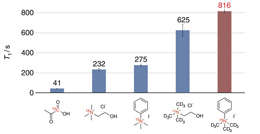Research Abstract
超偏極磁気共鳴化学プローブを設計するための基本骨格
化学的核の超偏極は、磁気共鳴画像法による特徴付けに対する感度を大きく向上させることが知られている。本稿では、さまざまな化学的検出用の超偏極プローブを設計できる新たな基本骨格を実証した。
A platform for designing hyperpolarized magnetic resonance chemical probes
2013年9月11日 Nature Communications 4 : 2411 doi: 10.1038/ncomms3411

超偏極は、磁気共鳴化学プローブの感度を向上させる極めて有望な手法である。今回我々は、さまざまな超偏極磁気共鳴化学プローブを設計するための基本骨格として、[15N, D9]トリメチルフェニルアンモニウムを報告する。この基本骨格構造は、15Nスピン-格子緩和時間が非常に長く(816 s, 14.1 T)、超偏極スピン状態を長く維持する。その寿命の長さゆえ、超偏極15Nシグナルを数十分間にわたって検出することができる。したがって、超偏極プローブの解析時間が本質的に短いという問題が克服される。また、この基本骨格を、それぞれカルシウムイオン、活性酸素種(過酸化水素)、酵素活性(カルボキシルエステラーゼ)を検出する3種の超偏極化学プローブに適用することによって、汎用性を実証している。設計したプローブの全てが、迅速な反応、化学シフト変化とともに高い感度を実現しており、15N磁気共鳴によって解析対象分子を高感度でリアルタイムモニタリングできる十分な性能を持つ。
野中 洋1, 秦 龍ノ介1, 堂浦 智裕1, 西原 達哉1, 熊谷 慶子2, 赤壁 麻依2, 津田 正史3, 市川 和洋4 & 山東 信介1, 4
- 九州大学 稲盛フロンティア研究センター
- 高知大学 総合研究センター
- 高知大学 海洋コア総合研究センター
- 九州大学 先端融合医療レドックスナビ研究拠点
Hyperpolarization is a highly promising technique for improving the sensitivity of magnetic resonance chemical probes. Here we report [15N, D9]trimethylphenylammonium as a platform for designing a variety of hyperpolarized magnetic resonance chemical probes. The platform structure shows a remarkably long 15N spin–lattice relaxation value (816 s, 14.1 T) for retaining its hyperpolarized spin state. The extended lifetime enables the detection of the hyperpolarized 15N signal of the platform for several tens of minutes and thus overcomes the intrinsic short analysis time of hyperpolarized probes. Versatility of the platform is demonstrated by applying it to three types of hyperpolarized chemical probes: one each for sensing calcium ions, reactive oxygen species (hydrogen peroxide) and enzyme activity (carboxyl esterase). All of the designed probes achieve high sensitivity with rapid reactions and chemical shift changes, which are sufficient to allow sensitive and real-time monitoring of target molecules by 15N magnetic resonance.

